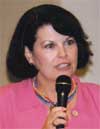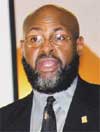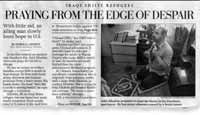Fall 2000
Mapping Pay Off: Better Stories
By Pat Ford
Pew Center
The Star-Gazette’s Kati Phillips immersed herself last spring in learning how to penetrate a community – find “third places” where people gather, learn how to approach them, how to engage in meaningful conversations that yield community stories.
The Elmira, N.Y., reporter felt like she had a lot of work ahead of her and she envied her colleague and classmate Charlie Coon, assuming he must already have a lot of this in his head.
“Charlie’s whole family lives (in the Elmira area). His brother is a bartender at a club in the city. He’s been to lots of different third places just through living here for a long time,” she remembers thinking. “They’re teaching us techniques for mapping. But those who’ve spent a long time in an area have their own mental map.”
Coon chuckles at Phillips’ perception. He left the seminars feeling like he had a lot of work ahead of him, too. “I might know some third places and be taking them for granted,” he says. “I might be spending a good hunk of my spare time in a third place and not be aware of it. (The seminars) made me aware that these places and people exist out there and it’s very easy as a reporter to fall into a pattern of relying on officials and the person on the street. It’s very easy to miss everyone in between.”
Indeed, that’s a major reason the Pew Center has supported a series of civic mapping seminars and published a do-it-yourself civic mapping manual, “Tapping Civic Life,” all based on research by The Harwood Institute for Public Innovation.
“We’re trying to get civic journalism out of projects and into every-day reflexes,” says Jan Schaffer, Pew Center’s executive director. “This is a useful, systematic way of doing journalism from the citizens’ level up.”
Phillips and Coon were among the reporters, producers and editors from 21 news organizations attending the seminars in the past 18 months.
Though the teams know it will take time to incorporate mapping techniques into their newsrooms, the teams from the spring seminars say they’re already seeing the benefits.
The News Star, Monroe, LA:
 |
Kathy Spurlock |
Executive Editor Kathy Spurlock says her reporters have already mined several stories by going into neighborhoods, finding stakeholders and engaging them in conversation. Spurlock enrolled to find a way to explore the issue of racial tension in Monroe. The city’s African-American community regarded The News Star as the white establishment newspaper and Spurlock was finding it hard to penetrate predominantly black neighborhoods and to provide balanced, diverse coverage of issues. Returning from the mapping seminars, she sent reporters to these neighborhoods with the kind of open-ended questions the seminars taught.
“When we started really talking to people about where they lived, things came out that were extraordinary,” Spurlock says. “There’s a dramatic lack of retail business in one large neighborhood… no bank, no post office, no place to buy stamps. What we were able to do was paint a more precise picture of why people in this community think there are problems, why they’re upset when a new post office opens and it’s not in their neighborhood. It’s one of those things you didn’t see till it was pointed out, then it’s very clear.”
Spurlock’s staff is building a Rolodex of sources in communities all over Monroe. Spurlock expects that that will take time but, along the way, the staff is generating stories from these contacts. “When people start seeing things in the paper they know they suggested or they were part of the conversation about, you build trust,” says Spurlock. “Every time we do a story, it snowballs. We get more calls and tips so we’re starting to make inroads.”
Detroit Free Press:
 |
John X. Miller |
Public Editor John X. Miller and Oakland County Editor Leesa Bainbridge have been training Free Press reporters in the mapping techniques they learned. Miller said one outcome is a July story about Iraqi immigrants running into hurdles in the health-care system.
The reporter used “catalysts and connectors,” knowledgeable community sources, who allowed her into the homes of people who helped her write meaningful stories. “That story led to a connection with the Iraqi community the paper has not had before,” said Miller. That dovetails with a project the Free Press was already planning – a handbook on Arab-American sources.

“We’re still searching for permanent ways to connect with the Arab-American community, ways that will remain in place even if [reporters] leave,” said Miller.
Bainbridge said her Oakland staff of 20 reporters is very enthusiastic about the concept. “We’re giving ourselves two communities to map by the end of the year,” said Bainbridge. “They embraced the idea of getting to know your community and working non-traditional sources.”
Star-Gazette, Elmira, NY:
Phillips and Coon can both point to stories they believe benefited from mapping techniques. Coon has been revisiting some of the catalysts, connectors and third places he’s long known and, sure enough, has found they are good sources for stories. For instance, former Elmira mayor Ed Lagonegro is a “connector,” someone who moves between lots of different organizations and people.

“He’s very well-connected in politics, local business and the charitable community,” said Coon, “but I hadn’t seen him or dealt with him much for years.” Contacting Lagonegro to put him on his civic map, Coon learned that a public housing complex was to be sold to a private landlord. The paper got the scoop on how residents were going to be impacted, the timeline for the transfer and a profile of the buyer.
Phillips said her stories include more voices and she asks questions that elicit more interesting information.
Deseret News and KSL-TV, Salt Lake City, UT:
The partners are planning joint coverage of this year’s statewide election campaigns. They’ve had training seminars and assigned teams to begin mapping work, said KSL Managing Editor Con Psarras. “We talk to people, find out what’s on their mind, then ask the people who are gathering names to collate the most relevant, salient points,” he said. “This is not intended to generate news stories but to guide our coverage. I’m confident it will distinguish our election coverage and bring us closer to the community.”
Wisconsin State Journal, Madison:
The paper is using civic mapping to improve its coverage of its African-American community. City Editor Joyce Dehli says the staff met after their first seminar to draw up a list of third places and different informal sources. Reporter Phil Brinkman then began doing informational interviews with the people identified. Rather than specific stories, Dehli says, the seminars have provided strategies for improving overall coverage. “We’re thinking more broadly, getting a truer understanding of the issues of importance,” she said, “Listening is where our greatest benefit has been so far.”